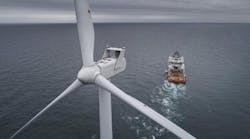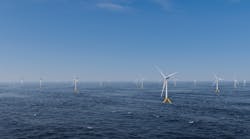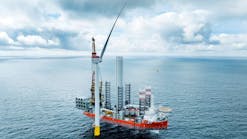Editor's note: A condensed version of this story first appeared in the 2023 Offshore Wind Special Report, which published within the September/October 2023 issue of Offshore magazine.
By Marco Alves, WavEC Offshore Renewables
As of the latest available information, the Portuguese government has announced its intentions to proceed with the development of offshore wind power in the country, specifically in the regions of Viana do Castelo, Leixões and Figueira da Foz. This initiative aims to harness the potential of deep waters for the implementation of offshore wind farms, with a combined capacity of up to 3.5 GW.
To initiate this process, the government has outlined its plan to launch a call for demonstrations of interest from relevant stakeholders in the offshore wind energy sector. These demonstrations of interest are non-binding in nature, allowing potential participants to express their intention to contribute to the development of offshore wind projects in the designated regions. This initial phase seeks to gauge the level of interest and involvement from the industry.
The call for demonstrations of interest is set to be opened soon and is expected to remain open until the end of the year. This duration is estimated to be about three months, suggesting the call may potentially extend into the beginning of 2024. This extended timeline provides ample opportunity for interested parties to thoroughly evaluate the possibilities and complexities of offshore wind projects in the designated regions.
Preparing for auction
Preparations for the upcoming offshore wind power auction in Portugal encompass a range of efforts undertaken by both governmental bodies and relevant entities within the industry. These initiatives aim to ensure a well-structured and informed auction process that maximizes the potential for successful offshore wind farm developments.
One crucial aspect of the preparations involves the government and relevant authorities working collaboratively to refine the competitive procedure models for the auction. This involves a comprehensive assessment and adjustment of the competitive processes that will be employed. The group responsible for this task is engaged in dialogue with potential stakeholders who have already demonstrated their interest in participating.
Particularly, the government is in the process of defining the strategic approach to ownership and responsibility for the installation of the electricity transmission infrastructure. These decisions are vital as they establish the framework within which the auction participants will operate. This strategic delineation will impact various aspects, including the structure of ownership, investment responsibilities and regulatory aspects of the offshore wind farms.
In parallel, entities such as WavEC Offshore Renewables are actively contributing to the preparations for the auction. These organizations support interested parties that seek to enhance their understanding of the auction process by offering their expertise in legal, economic and technical aspects related to the offshore wind sector.
The developers and utilities mentioned previously have publicly expressed their interest in the offshore wind tenders in Portugal. However, due to confidentiality reasons, it's possible that other entities are interested but haven't been publicly disclosed. Unfortunately, WavEC, as a supporting entity, cannot reveal such confidential information about potential participants.
Proposed projects/technology
So far, only a limited amount of information has been released by developers regarding potential projects/technologies. To better define their projects and strategies, developers are certainly waiting for more information that will come from various sources. In this framework, a working group was created by the government in September 2022 with the purpose of defining:
- A set of spatialized areas under the terms of the Allocation Plan, that is being prepared, with an indication of the interconnection points to the National Electricity Transmission Network, to be allocated to the offshore renewable power generation plants, within the scope of the National Maritime Spatial Planning Situation Plan;
- A temporal sequencing of these areas, establishing offshore wind power capacity indications to be assigned to each area;
- The model for assigning capacity reserve titles for electricity injection in the Public Service Electrical Network and the associated titles of private use of the maritime space;
- The technical and investment model for the development of electrical infrastructure offshore and onshore necessary for the entry into operation of the electricity generation plants, considering the expected increased demand for green electricity because of the industrial investments foreseen for the national territory, namely hydrogen production and derivatives; and
- The development needs of port infrastructures, whether for the construction of power generation plants or for the development of an industrial sector national based on FER-offshore.
A preliminary proposal of the report was in public hearing between Jan. 30 and March 10, with a view to formulating suggestions and collecting contributions from all the stakeholders. The final version of the document was released in July, with an update resulting from the gathered contributions and suggestions, which certainly serve as a basis for developers to start defining projects and choosing technologies.
Additionally, the working group also recommended a prequalification phase, whose criteria are not yet known (in principle, the prequalification criteria will be released in September) but will certainly impact on the definition of projects. The prequalification phase relies on the technical and financial solvency of promoters of way to minimize the risks in projects of great complexity, with at least 70% of the classification linked to cost to guarantee the best possible price for the system and the final consumer, and 30% of non-price criteria that assess the sustainability of projects from an environmental perspective and social. Eventually, the definition of the projects also depends on geophysical survey and geotechnical site investigation in the areas of interest to developers, which themselves will have to carry out in the first auction (3.5 GW) of the plan to launch successive auctions for a total of 10 GW.
Impacting Portugal's energy system
The emerging offshore wind industry presents numerous challenges and uncertainties. These challenges comprise a wide range of key areas that require particular attention, including the availability/existence of specialized vessels (SOV, CTV, cable layers), the adaptation of the grid infrastructure, the limitations in draft and crane capacity of ports, and the issue of securing steady supply of steel and raw materials (including some rare elements). Additionally, the immaturity of the supply chain, the need to enhance knowledge on potential environmental impacts (such as bird collisions and underwater noise) as well as improving sites characterization through geotechnical and geophysical surveys are crucial elements. Furthermore, ensuring public acceptance to avoid conflicts with other sectors and implementing effective support mechanisms are also important considerations.
However, if Portugal and the industry itself show the ability to mitigate the challenges surrounding the emerging offshore wind industry, its impact on the Portuguese energy system is expected to be immense, although quantifying it may be difficult. Despite that, a recent study conducted by WavEC concluded that if the 10-GW target of installed capacity is reached, this will represent an annual energy production of 35 TWh/year (roughly 73% of the current annual electricity consumption in the country), which will promote the creation of 95,000 direct jobs and similar number of indirect jobs (approximately 165% of the total jobs in the electricity, gas and water sector) and reduce greenhouse-gas (GHG) emissions of about 16 MTon CO2e per year (almost 30% of the total GHG emissions in 2020).
The introduction of offshore wind in Portugal will also advance the country's renewable energy portfolio, aligning with its emissions reduction goals. However, this transition also brings complexities. The growth of offshore wind may lead to grid management issues like curtailment and excess production during high wind periods. To address these challenges, innovative solutions like green hydrogen production and storage can be pivotal. This dual impact emphasizes the need for a comprehensive approach that balances renewable energy expansion with effective strategies to ensure grid stability and optimize energy use.
WavEC's involvement
WavEC has been deeply involved in the development of this sector for almost 20 years, providing technoeconomic assessment services (estimation of LCOE and/or other financial indicators), environmental monitoring and mitigation measures, optimization of O&M and logistics, and support technology developers in design optimizations that may lead to improve performance and to LCOE reductions (e.g., numerical modeling of platform dynamics, structure loads, mooring design and umbilical dynamics).
Moreover, WavEC has been working with several developers interested in the offshore wind development in Portugal, providing, among other activities, support on:
- Bid strategy development and advice on addressing prequalification criteria;
- General advice on consenting and permitting processes (e.g., procedures, legislation and documentation requirements);
- Stakeholders’ engagement (including regulators, authorities, environmental non-governmental organizations and fisheries);
- Identification of key consents risks related to bid and tender procedure, consenting strategy, legislation, etc.; and
- Review of the strategic environmental assessment and marine spatial plan general advice on consenting and permitting procedures.
Recently, WavEC established an alliance with OWC, a company of the ABL group, with which WavEC has developed a close collaboration in recent years, to reinforce its capacity/competences and bring to Portugal the experience that OWC has acquired in other auctions. For example, in the ScotWind auction, OWC successfully supported and guided all the developers in drafting their bids, resulting in their collective success.









